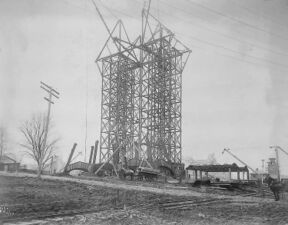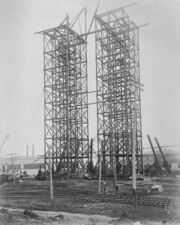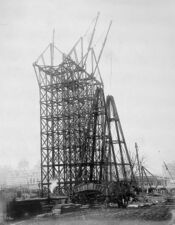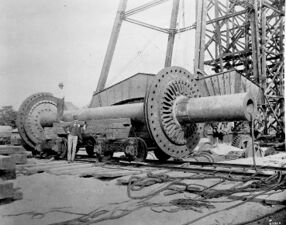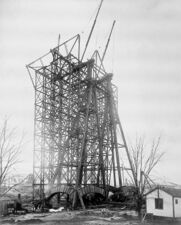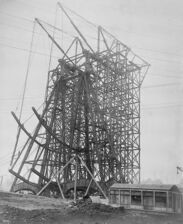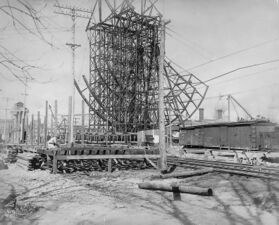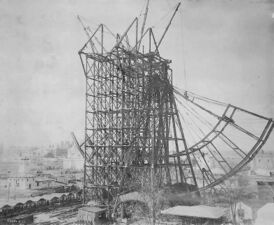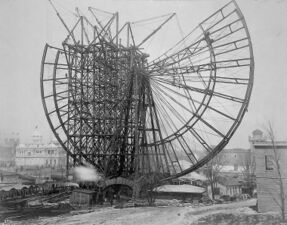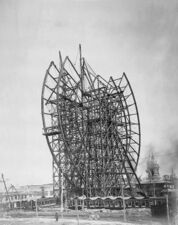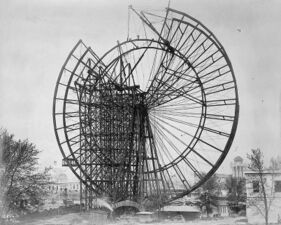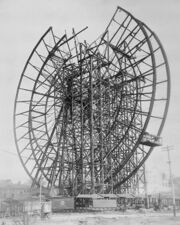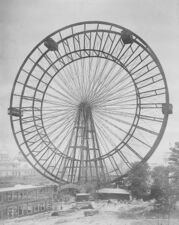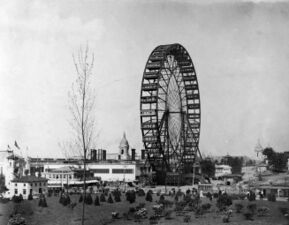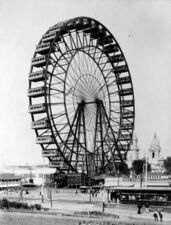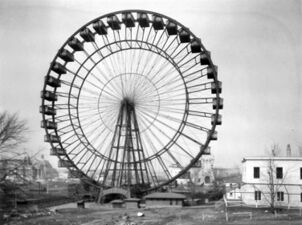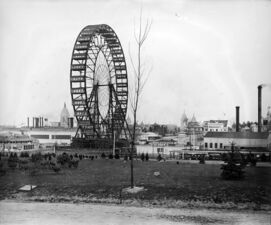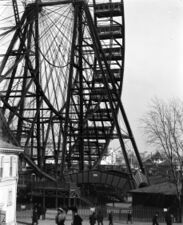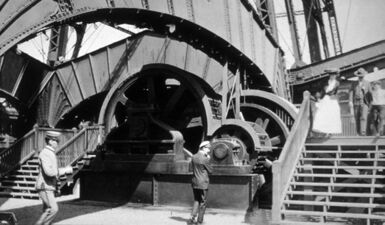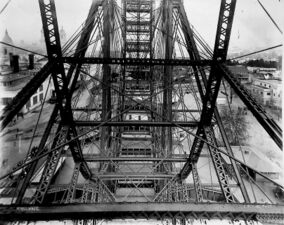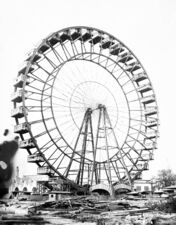Ferris Wheel: Difference between revisions
(Created page with "{{short description|Ferris Wheel}} {{Infobox prepared food | name = Ferris Wheel | image = Ferris Wheel.jpg | image_size = 300px | caption = Ferris Wheel | alternate_name = Observation Wheel | country = | creator = | course = | cost = $380,000 ({{Inflation|US|380,000|1904|fmt=eq}}) | admission = .50 ({{Inflation|US|.50|1904|fmt=eq}}) | profit = $267,000 ({{Inflation|US|267...") |
No edit summary |
||
| (19 intermediate revisions by the same user not shown) | |||
| Line 1: | Line 1: | ||
{{ | {{SHORTDESC:Ferris Wheel}} | ||
{{Infobox | {{Infobox FairBuilding | ||
| name = Ferris Wheel | | name = Ferris Wheel | ||
| image = Ferris Wheel.jpg | | image = Ferris Wheel.jpg | ||
| image_size = | | image_alt = | ||
| image_size = 400px | |||
| caption = Ferris Wheel | | caption = Ferris Wheel | ||
| alternate_name = Observation Wheel | | alternate_name = Observation Wheel | ||
| | | location = [[The Trail]] | ||
| no_buildings = 1 | |||
| | | construction_cost= $380,000 (${{Format price|{{Inflation|US|380,000|1904}}}} in {{Inflation/year|US}}) | ||
| | | furnishing_cost = | ||
| profit = $267,000 (${{Format price|{{Inflation|US|267,000|1904}}}} in {{Inflation/year|US}}) | |||
| profit = $267,000 ({{Inflation|US|267,000|1904| | | owner = Chicago House Wrecking Company | ||
| owner = | | architect = George Washington Gale Ferris Jr. | ||
| | | dimensions = | ||
| | | adult_entry = 50¢ (${{Inflation|US|.5|1904}} in {{Inflation/year|US}}) | ||
| | | child_entry = | ||
| opening_day = May 28, 1904 | |||
| dedication_day = | |||
| special_day = | |||
| other = | | other = | ||
}} | }} | ||
Located on [[The Trail]], the | |||
Located on [[The Trail]], the '''Ferris Wheel''', built by George Washington Gale Ferris Jr. was a symbol of the Fair. | |||
==Description== | |||
The observation wheel was 264 feet high. Two steel forks held up a 70-ton, 46 1/2' axle. | |||
Two steam engines, arranged in a dual reversing engine provided 2,000hp to rotate the 4,200 ton wheel. The power was applied through a series of cogs to a sprocket chain which engages wide cogs on the outside of each rim. An oversized air brake was used for stopping. | |||
The wheel could accommodate 2,160 passengers at a time. 36 cars (13' x 26') were attached to the wheel. The cars were made of steel, clad in wood. Each car held a security attendant, and could hold 60 standing passengers, or 40 passengers sitting on swivel chairs. On October 19, 1893 a record 1,784 were carried on a trip on the Wheel; but typical average ridership was much less. | |||
It took about 20 minutes to complete two revolutions, the first involving up to six stops to allow passengers to exit and enter other cars, and the second a nine-minute non-stop rotation. | |||
==Before the Fair== | ==Before the Fair== | ||
===George Ferris=== | |||
Ferris was born on Valentine's Day, 1859, in Galesburg Illinois. He graduated from the California Military Academy and Rensselaer Polytechnic Institute and soon became a bridge-builder in Pittsburgh, Pennsylvania. He began his career in the railroad industry and then pursued an interest in bridge building. | |||
Ferris understood the growing need for structural steel and founded G.W.G. Ferris & Co. in Pittsburgh, a firm that tested and inspected metals for railroads and bridge builders. | |||
Ferris claimed that he developed he concept for the Ferris wheel while at a dinner in Chicago. | |||
Ferris' one-of-a-kind design was able to carry five times the 1,200 ton capacity limit. In 80 miles an hour winds, the sway of the colossal wheel was less than half an inch. | |||
In November 1892, he started the Pittsburgh Construction Company to build the great Wheel. George Ferris began his efforts to design the great wheel before he even received approval or funding from the Exposition. (There were no funds available for what would be an engineering marvel.) Though his first proposal was rejected by the Fair's organizers, he continued, and his second proposal was accepted and approved in late 1892. | |||
The structure was created in Pittsburgh (but sections were made at nine steel mills in Detroit, and in Cleveland and Youngstown Ohio, Pittsburgh and Bethlehem, Pennsylvania). | |||
Ferris thought the 1893 fair management had robbed him and his investors of his cut in the $726,805 (${{Format price|{{Inflation|US|726,805|1904}}}} in {{Inflation/year|US}}) profit that his wheel had brought in. | |||
Constantly in litigation, Ferris continued to create smaller wheels, selling them mostly to amusement parks across the U.S., but he made little profit. Ferris desired to build and sell bigger and better wheels, but demand was sporadic. | |||
After his wife left him in 1896, Ferris suffered from depression. He died alone on Nov. 21, 1896, bankrupt at the age of 37, in Pittsburgh's Mercy Hospital. Ferris never saw his masterpiece creation rise again in St. Louis. | |||
Ferris | Ferris never sought or received a patent for his marvelous wheel-invention. George Ferris Jr.'s design for the observation wheel was copied by owners of resorts (such as Coney Island). | ||
===Chicago's World Fair=== | |||
The Ferris Wheel opened to the public on June 21, 1893 (50 days after the exposition's May 1st opening day). The first riders included George Ferris, his wife, special invited guests, the Chicago City Council, and the 40-piece Iowa State band. The wheel operated daily, from 8 AM to 11 PM for the duration of the Fair. | |||
The Exposition ended in October 1893, and the Wheel closed in November 1893. Beginning in April 1894, it was dismantled in about 10 weeks, and was stored on a railway siding until the following year. | |||
Ferris' one-of-a-kind | ===Ferris Wheel Park=== | ||
In 1895, the Wheel was rebuilt on Chicago's North Side, on Clark Street near Lincoln Park, next to an exclusive neighborhood. A '''Ferris Wheel Park'' was created for this one-of-a-kind attraction. | |||
However, few were happy with this giant ride being in their neighborhood. William D. Boyce, a local resident representing a large contingent of opposing residents, filed a Circuit Court action against the owners of the wheel to have it removed; but his efforts failed. | |||
The wheel operated on Clark Street from October 1895 until 1903, when the Chicago House Wrecking Company (CHWC) purchased the great Wheel for $8,150 (${{Format price|{{Inflation|US|8150|1904}}}} in {{Inflation/year|US}}) at auction. They planned to sell, re-use, or salvage the giant wheel. | |||
The CHWC was a large, profitable, family-owned salvage company that also had purchased and salvaged much of the remains of Chicago's 1893 Columbian Exposition. Their previous experience also included the demolition and salvage of other large structures and world's fairs (Omaha 1898, and Buffalo 1901). In 1904 the CHWC was the largest salvage company in the USA. | |||
==St. Louis== | |||
178 freight cars brought the huge attraction the St. Louis at a cost of $150,000 (${{Format price|{{Inflation|US|150,000|1904}}}} in {{Inflation/year|US}}). However, the wheel recouped its relocation coats in only four months of operation. | |||
The Ferris Wheel would open four weeks after the opening of the fair, on May 28, 1904. | |||
Operating the Ferris Wheel required 44 persons, including guards, platform guides, an engineer and a fireman. The boiler required four tons of coal for each day’s operations. Three million people were carried without injury. The wheel carried approximately 7.5 percent of the paid admissions to the Fair each day. | |||
On July 12 1904, Mrs. Maud Nicholson, of Lagonda, Indiana, a dare-devil made one entire revolution of the huge Observation Wheel standing on top of one of the cars. | |||
The wheel | ===Erection=== | ||
The Ferris Wheel was erected at the very center of the fair, near but not in [[The Pike]]. After the foundations were prepared, two 140-foot steel towers were constructed amid massive wooden scaffolding and lifts. Then the 71-ton axle was carefully lifted and locked into position on these towers. Then the connecting rods were attached to the flanges, to begin to build the steel girder framework for the wheel. | |||
<gallery |="" class="center" mode="packed-hover" widths="150px" heights="150px">> | |||
File:Wheel-Construction 1.jpg | Scaffolding Erected | |||
File:Wheel-Construction 2.jpg | Bases Erected | |||
File:Wheel-Construction 3.jpg | Support Posts | |||
File:Wheel-Construction 4.jpg | Axle Ready to be placed | |||
File:Wheel-Construction 5.jpg | Axle in place | |||
File:Wheel-Construction 6.jpg | Outer Rim Start | |||
File:Wheel-Construction 7.jpg | Outer Rim Continues | |||
File:Wheel-Construction 8.jpg | Outer Rim | |||
File:Wheel-Construction 9.jpg | Outer Rim | |||
File:Wheel-Construction 10.jpg | Outer Rim | |||
File:Wheel-Construction 11.jpg | Outer Rim | |||
File:Wheel-Construction 12.jpg | Outer Rim | |||
File:Wheel-Construction 13.jpg | Initial cars placed | |||
</gallery> | |||
===Weddings=== | |||
Individual cars could be rented out for weddings and other special engagements. | Individual cars could be rented out for weddings and other special engagements. | ||
There were 50 marriage ceremonies on the great wheel, the firs happening on opening day of the Wheel. Weddings became so popular that Car #19 was decorated for weddings, and even had a piano in it at times. On July 16, one couple was married inside Car #19, sitting on horseback. Another daring wedding even took place on a platform constructed on top of one of the large cars! | |||
===Deaths=== | |||
Three people have died building the great Observation Wheel. One steelworker was killed during the construction of the Wheel, and another died during disassembly when he fell from the axle. | |||
==After The Fair== | ==After The Fair== | ||
The Chicago House Wrecking Company | The Chicago House Wrecking Company attempted to sell the Ferris Wheel to the operators of Coney Island amusement park in New York. | ||
masterpiece would be toppled and sold for scrap. Their profit 1,800 | |||
The estimated costs of taking down and re-erecting the wheel there would have been approximately $166,500 (${{Format price|{{Inflation|US|166,500|1904}}}} in {{Inflation/year|US}}), while the salvage value, if the wheel were wrecked, was approximately $75,950 (${{Format price|{{Inflation|US|75,950|1904}}}} in {{Inflation/year|US}}). | |||
After Coney Island declined to purchase the wheel, it was deemed too expensive to ship (and to store); it was decided that on May 11th, 1906, Ferris' masterpiece would be toppled and sold for scrap. Their profit was $1,800 (${{Format price|{{Inflation|US|1,800|1904}}}} in {{Inflation/year|US}}). | |||
100 pounds of dynamite collapsed the wheel into a 90 foot-wide mass of wreckage. | |||
===The Axle=== | ===The Axle=== | ||
[[File:Last Axle.jpg|200px|left|Article describing the Ferris Wheel Removal.]] | |||
The axle, 45 feet long, 32 inches in diameter, it was cast of hardened steel, and hollow (about 15-16 inches); thus, it was 8-9 inches “thick”. With its “spiders” (flanges for rod connection), it weighed over 71 tons (over 140,000 pounds). Because of the sheer size of the axle, many rumors and myths circulated that the axle was impossible to cut up or haul away and had been buried on the site of the fair [[Forest Park]]. | |||
In May 2007, a cesium magnetometer survey around the wheel's 1904 location reported finding some evidence of a long metal artifact buried under Skinker Boulevard (possibly the axle). | |||
While there is no photographic evidence of the axle removal, consider the following facts: | |||
*The axle had previously been moved three times by the CHWC. They had two special flatbed train cars built for the purpose. | |||
*After the wheel was blown up, removal of the debris (including the axle) would likely not have been "newsworthy". | |||
*The CHWC owned the Ferris Wheel and was under contract to remove the wheel and all other remnants of the fair from Forest Park. | |||
*The axle alone was worth close to $1,000 (${{Format price|{{Inflation|US|1,000|1904}}}} in {{Inflation/year|US}}) as salvage. | |||
*There are several documented reports of the axle being taken back to Chicago: | |||
** Eleanor Harris, daughter of CHWC president Abraham Harris saw the axle in the company’s “scrap yards for several years” … and that it was eventually "cut up for scrap" <ref> Norman Anderson, ''Ferris Wheels: An Illustrated History'', pg. 74 </ref> | |||
** A memo from Frank Harris stating that he is opposed to selling the axle at a give-away price. Further, he assigns a salvage value to the axle, based on its weight. He states "I would prefer shipping it to Chicago and dispose of it at some future date, even if we do have to keep it two or three years." <ref> Abraham Harris, company president, to Frank Harris, company Treasurer, Memo, September 10, 1906</ref> | |||
** A letter stating ''the axle was returned to the Chicago yard of the Chicago House Wrecking Company; when oxy-acetylene torches became strong enough to cut up the hardened steel of the massive 70-ton axle (c.1918-1919), it was cut up for scrap.'' <nowiki></ref></nowiki> Mr. Mortimer B. Harris (vice president of the Harris Brothers Company, the successor to the Chicago House Wrecking Company), and T. J. Riordan, an active CHWC employee, Letters, October 1951 <nowiki></ref></nowiki> | |||
** Leo Harris, the grandson of Frank Harris, who was Treasurer of the Chicago House Wrecking Company, wrote “…the giant axle of the wheel was returned to the yards of the CHWC, where it remained until it was cut up for its steel content at the beginning of World War I.” <ref> Wrecking to Save World’s Fairs, Ephemera Journal, 2011 </ref> | |||
**A report on the Ferris Wheel: "The last of the Ferris Wheel has been taken away. The seventy-ton steel axle, which imbedded itself in the ground when the wheel was dynamited, was pulled from its resting place by a huge derrick. It was found necessary to blow off the flanges from the axle with dynamite before it could be loaded on a car." <ref> ,''Clinton Register'', 1 Feb. 1907 </ref> | |||
Based on these facts the axle of the Ferris Wheel was returned to Chicago in 1906, and eventually cut up for scrap around 1918-1919. | |||
==Gallery== | |||
<gallery | class="center" | mode=packed-hover | widths=150px heights=150px>> | |||
File:Wheel 1.jpg | Ferris Wheel | |||
File:Wheel 2.jpg | Ferris Wheel | |||
File:Wheel 4.jpg |Ferris Wheel | |||
File:Wheel 5.jpg | Ferris Wheel | |||
File:Wheel 3.jpg | Base of Ferris Wheel | |||
File:Wheel - Gears.JPG | Machinery to move the Wheel | |||
File:Wheel - Interior.jpg | Looking inside from a car | |||
File:Wheel - After Fair.jpg |After the close of the Fair | |||
</gallery> | |||
==See also== | ==See also== | ||
Latest revision as of 20:03, 30 November 2022
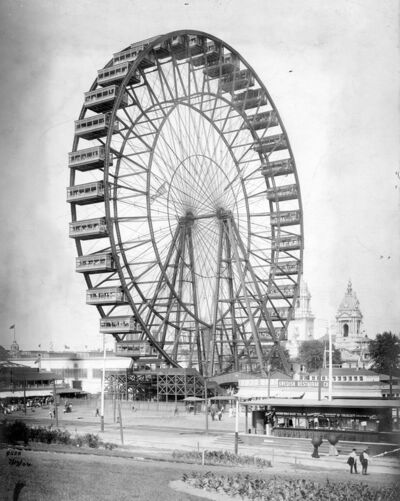 | |
| Alternative names | Observation Wheel |
|---|---|
| Location | The Trail |
| No. of Buildings | 1 |
| Owner | Chicago House Wrecking Company |
| Construction | |
| Construction Cost | $380,000 ($11.5 million in 2021) |
| Proft | $267,000 ($8.05 million in 2021) |
| Entry | |
| Adult Entry | 50¢ ($15 in 2021) |
| Architecture | |
| Architect | George Washington Gale Ferris Jr. |
Located on The Trail, the Ferris Wheel, built by George Washington Gale Ferris Jr. was a symbol of the Fair.
Description[edit | edit source]
The observation wheel was 264 feet high. Two steel forks held up a 70-ton, 46 1/2' axle.
Two steam engines, arranged in a dual reversing engine provided 2,000hp to rotate the 4,200 ton wheel. The power was applied through a series of cogs to a sprocket chain which engages wide cogs on the outside of each rim. An oversized air brake was used for stopping.
The wheel could accommodate 2,160 passengers at a time. 36 cars (13' x 26') were attached to the wheel. The cars were made of steel, clad in wood. Each car held a security attendant, and could hold 60 standing passengers, or 40 passengers sitting on swivel chairs. On October 19, 1893 a record 1,784 were carried on a trip on the Wheel; but typical average ridership was much less.
It took about 20 minutes to complete two revolutions, the first involving up to six stops to allow passengers to exit and enter other cars, and the second a nine-minute non-stop rotation.
Before the Fair[edit | edit source]
George Ferris[edit | edit source]
Ferris was born on Valentine's Day, 1859, in Galesburg Illinois. He graduated from the California Military Academy and Rensselaer Polytechnic Institute and soon became a bridge-builder in Pittsburgh, Pennsylvania. He began his career in the railroad industry and then pursued an interest in bridge building.
Ferris understood the growing need for structural steel and founded G.W.G. Ferris & Co. in Pittsburgh, a firm that tested and inspected metals for railroads and bridge builders.
Ferris claimed that he developed he concept for the Ferris wheel while at a dinner in Chicago.
Ferris' one-of-a-kind design was able to carry five times the 1,200 ton capacity limit. In 80 miles an hour winds, the sway of the colossal wheel was less than half an inch.
In November 1892, he started the Pittsburgh Construction Company to build the great Wheel. George Ferris began his efforts to design the great wheel before he even received approval or funding from the Exposition. (There were no funds available for what would be an engineering marvel.) Though his first proposal was rejected by the Fair's organizers, he continued, and his second proposal was accepted and approved in late 1892.
The structure was created in Pittsburgh (but sections were made at nine steel mills in Detroit, and in Cleveland and Youngstown Ohio, Pittsburgh and Bethlehem, Pennsylvania).
Ferris thought the 1893 fair management had robbed him and his investors of his cut in the $726,805 ($21.9 million in 2021) profit that his wheel had brought in.
Constantly in litigation, Ferris continued to create smaller wheels, selling them mostly to amusement parks across the U.S., but he made little profit. Ferris desired to build and sell bigger and better wheels, but demand was sporadic.
After his wife left him in 1896, Ferris suffered from depression. He died alone on Nov. 21, 1896, bankrupt at the age of 37, in Pittsburgh's Mercy Hospital. Ferris never saw his masterpiece creation rise again in St. Louis.
Ferris never sought or received a patent for his marvelous wheel-invention. George Ferris Jr.'s design for the observation wheel was copied by owners of resorts (such as Coney Island).
Chicago's World Fair[edit | edit source]
The Ferris Wheel opened to the public on June 21, 1893 (50 days after the exposition's May 1st opening day). The first riders included George Ferris, his wife, special invited guests, the Chicago City Council, and the 40-piece Iowa State band. The wheel operated daily, from 8 AM to 11 PM for the duration of the Fair.
The Exposition ended in October 1893, and the Wheel closed in November 1893. Beginning in April 1894, it was dismantled in about 10 weeks, and was stored on a railway siding until the following year.
Ferris Wheel Park[edit | edit source]
In 1895, the Wheel was rebuilt on Chicago's North Side, on Clark Street near Lincoln Park, next to an exclusive neighborhood. A 'Ferris Wheel Park was created for this one-of-a-kind attraction.
However, few were happy with this giant ride being in their neighborhood. William D. Boyce, a local resident representing a large contingent of opposing residents, filed a Circuit Court action against the owners of the wheel to have it removed; but his efforts failed. The wheel operated on Clark Street from October 1895 until 1903, when the Chicago House Wrecking Company (CHWC) purchased the great Wheel for $8,150 ($245,798 in 2021) at auction. They planned to sell, re-use, or salvage the giant wheel.
The CHWC was a large, profitable, family-owned salvage company that also had purchased and salvaged much of the remains of Chicago's 1893 Columbian Exposition. Their previous experience also included the demolition and salvage of other large structures and world's fairs (Omaha 1898, and Buffalo 1901). In 1904 the CHWC was the largest salvage company in the USA.
St. Louis[edit | edit source]
178 freight cars brought the huge attraction the St. Louis at a cost of $150,000 ($4.52 million in 2021). However, the wheel recouped its relocation coats in only four months of operation.
The Ferris Wheel would open four weeks after the opening of the fair, on May 28, 1904.
Operating the Ferris Wheel required 44 persons, including guards, platform guides, an engineer and a fireman. The boiler required four tons of coal for each day’s operations. Three million people were carried without injury. The wheel carried approximately 7.5 percent of the paid admissions to the Fair each day.
On July 12 1904, Mrs. Maud Nicholson, of Lagonda, Indiana, a dare-devil made one entire revolution of the huge Observation Wheel standing on top of one of the cars.
Erection[edit | edit source]
The Ferris Wheel was erected at the very center of the fair, near but not in The Pike. After the foundations were prepared, two 140-foot steel towers were constructed amid massive wooden scaffolding and lifts. Then the 71-ton axle was carefully lifted and locked into position on these towers. Then the connecting rods were attached to the flanges, to begin to build the steel girder framework for the wheel.
-
Scaffolding Erected
-
Bases Erected
-
Support Posts
-
Axle Ready to be placed
-
Axle in place
-
Outer Rim Start
-
Outer Rim Continues
-
Outer Rim
-
Outer Rim
-
Outer Rim
-
Outer Rim
-
Outer Rim
-
Initial cars placed
Weddings[edit | edit source]
Individual cars could be rented out for weddings and other special engagements.
There were 50 marriage ceremonies on the great wheel, the firs happening on opening day of the Wheel. Weddings became so popular that Car #19 was decorated for weddings, and even had a piano in it at times. On July 16, one couple was married inside Car #19, sitting on horseback. Another daring wedding even took place on a platform constructed on top of one of the large cars!
Deaths[edit | edit source]
Three people have died building the great Observation Wheel. One steelworker was killed during the construction of the Wheel, and another died during disassembly when he fell from the axle.
After The Fair[edit | edit source]
The Chicago House Wrecking Company attempted to sell the Ferris Wheel to the operators of Coney Island amusement park in New York.
The estimated costs of taking down and re-erecting the wheel there would have been approximately $166,500 ($5.02 million in 2021), while the salvage value, if the wheel were wrecked, was approximately $75,950 ($2.29 million in 2021).
After Coney Island declined to purchase the wheel, it was deemed too expensive to ship (and to store); it was decided that on May 11th, 1906, Ferris' masterpiece would be toppled and sold for scrap. Their profit was $1,800 ($54,287 in 2021).
100 pounds of dynamite collapsed the wheel into a 90 foot-wide mass of wreckage.
The Axle[edit | edit source]
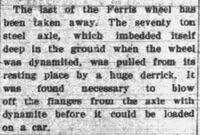
The axle, 45 feet long, 32 inches in diameter, it was cast of hardened steel, and hollow (about 15-16 inches); thus, it was 8-9 inches “thick”. With its “spiders” (flanges for rod connection), it weighed over 71 tons (over 140,000 pounds). Because of the sheer size of the axle, many rumors and myths circulated that the axle was impossible to cut up or haul away and had been buried on the site of the fair Forest Park.
In May 2007, a cesium magnetometer survey around the wheel's 1904 location reported finding some evidence of a long metal artifact buried under Skinker Boulevard (possibly the axle).
While there is no photographic evidence of the axle removal, consider the following facts:
- The axle had previously been moved three times by the CHWC. They had two special flatbed train cars built for the purpose.
- After the wheel was blown up, removal of the debris (including the axle) would likely not have been "newsworthy".
- The CHWC owned the Ferris Wheel and was under contract to remove the wheel and all other remnants of the fair from Forest Park.
- The axle alone was worth close to $1,000 ($30,159 in 2021) as salvage.
- There are several documented reports of the axle being taken back to Chicago:
- Eleanor Harris, daughter of CHWC president Abraham Harris saw the axle in the company’s “scrap yards for several years” … and that it was eventually "cut up for scrap" [1]
- A memo from Frank Harris stating that he is opposed to selling the axle at a give-away price. Further, he assigns a salvage value to the axle, based on its weight. He states "I would prefer shipping it to Chicago and dispose of it at some future date, even if we do have to keep it two or three years." [2]
- A letter stating the axle was returned to the Chicago yard of the Chicago House Wrecking Company; when oxy-acetylene torches became strong enough to cut up the hardened steel of the massive 70-ton axle (c.1918-1919), it was cut up for scrap. </ref> Mr. Mortimer B. Harris (vice president of the Harris Brothers Company, the successor to the Chicago House Wrecking Company), and T. J. Riordan, an active CHWC employee, Letters, October 1951 </ref>
- Leo Harris, the grandson of Frank Harris, who was Treasurer of the Chicago House Wrecking Company, wrote “…the giant axle of the wheel was returned to the yards of the CHWC, where it remained until it was cut up for its steel content at the beginning of World War I.” [3]
- A report on the Ferris Wheel: "The last of the Ferris Wheel has been taken away. The seventy-ton steel axle, which imbedded itself in the ground when the wheel was dynamited, was pulled from its resting place by a huge derrick. It was found necessary to blow off the flanges from the axle with dynamite before it could be loaded on a car." [4]
Based on these facts the axle of the Ferris Wheel was returned to Chicago in 1906, and eventually cut up for scrap around 1918-1919.
Gallery[edit | edit source]
-
Ferris Wheel
-
Ferris Wheel
-
Ferris Wheel
-
Ferris Wheel
-
Base of Ferris Wheel
-
Machinery to move the Wheel
-
Looking inside from a car
-
After the close of the Fair
